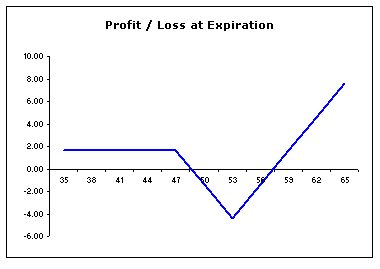I see a lot of hands going up, which doesn’t surprise me, as I also think the markets are at one of those crossroads that precedes a big move. The problem, of course, is getting the direction right.
The most popular way to play a large anticipated move of undetermined direction is with a long straddle or a long strangle. If you get a big move – and particularly if you get is shortly after initiating the position – you will likely be able to lock in a substantial profit. Losses are limited to the cost of opening the position, but if volatility is widely expected, the position can be expensive to open and time decay can be painful.
For what it’s worth, I am often partial to a different approach: call backspreads and put backspreads. There a couple of important distinctions between a straddle/strangle approach and a backspread approach. First of all, straddles and strangles can entail a significant initial outlay. With backspreads, on the other hand, you can essentially finance the excess out of the money calls or puts by selling some at the money or slightly out of the money options and end up with a net credit or zero cost transaction. Second, if the options sold are at the money or out of the money, you will make money if the underlying does not move. Finally, as the graphic below (of a call backspread) demonstrates, the big windfall with a back spread is unidirectional. So unlike the straddle or strangle, large profits only accrue when you can call the direction of the move.

If you are interested in learning more about backspreads, check out John Summa’s Backspreads: Good News for Breakout Traders article in Investopedia.com.
0 comments:
New comments are not allowed.